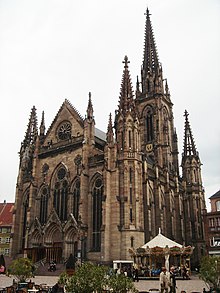|
Jean-Baptiste Schacre Jean-Baptiste Schacre (1808–1876) was a French architect. LifeBorn in Delle in 1808, Jean-Baptiste Schacre began his career in 1826 as a draftsman in the Ponts et Chaussées services. During that period he drew many sketches and watercolours depicting Alsatian landscapes and monuments. Becoming Chief draftsman on the Strasbourg-Basel railway, he settled in Mulhouse in 1838, where he opened his own architectural office in 1841. From 1844 until his death, Schacre was "architecte voyer" (city architect and road surveyor) of Mulhouse. As such he erected some significant buildings in the city, such as the synagogue (1846-1849), the Catholic Church of Saint-Steffen (Gothic revival, 1855-1860) and the Calvinist temple of Saint-Steffen (Gothic revival, 1859-1869). In the 1860s he designed many churches through the Department of Haut-Rhin, most of them in Romanesque revival style. He died in Mulhouse. Main worksDrawings
ArchitectureMulhouse
Other places
Gallery
References
Wikimedia Commons has media related to Jean-Baptiste Schacre. |


